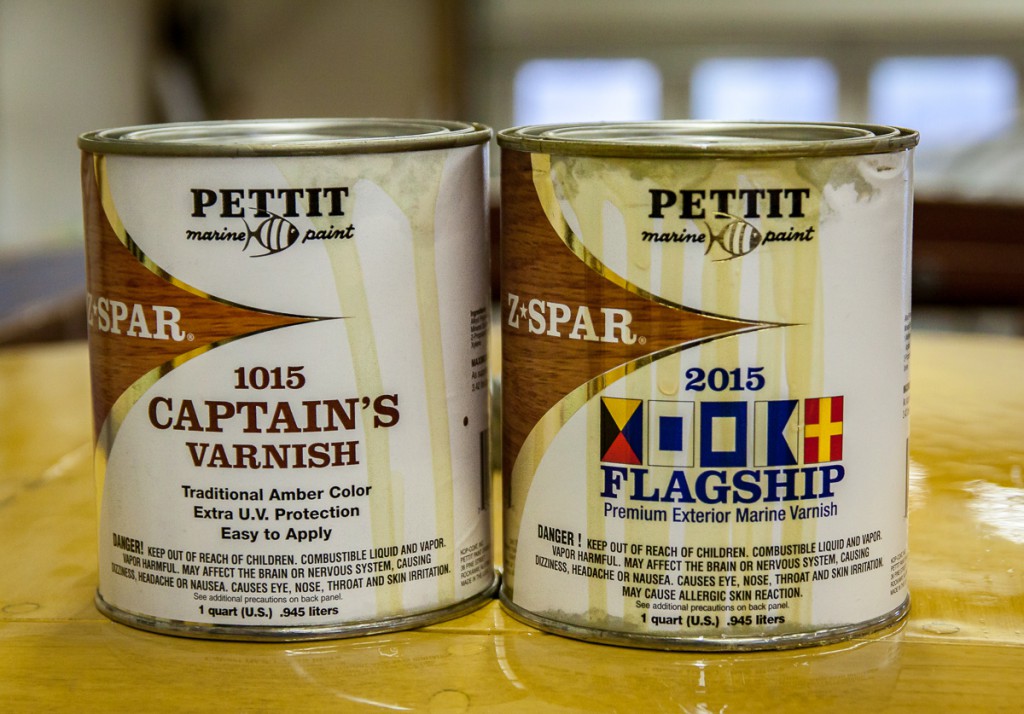The Mystique of Varnish
Ask anyone who works on their wooden boat about varnish and you are likely to receive an opinionated dissertation on their technique for varnishing. Getting a good varnish job is challenging, frustrating and rewarding all at the same time. I like to say that varnishing is one part prep, one part technique and one part luck.
Even before honing your technique, you have to choose a varnish. There are many types and brands. People often swear by one. After spreading countless gallons over the years, I’ve come to the conclusion that there are many right combinations of varnish and technique, you just have to find what works for you.
The obvious big names in the varnish world are Interlux, Pettit and Epifanes. For my shop, each has it’s own use, though I use more Pettit product than any other.
My Interlux experience is limited to their Jet Speed product, a rather thin and fast drying varnish. Being thin, it works well for spray application, which I like to do after staining. Spraying doesn’t disturb the stain like brushing can, and it’s a great way to get a few good seal coats on.
Captain’s Varnish by Pettit is one of the easiest varnished to work with. It is medium bodied, flows out nicely, and has a light amber color. Captain’s dries quickly and is reasonably hard in twenty-four hours so you can climb across a deck to work on something without fear that you are damaging the finish. However, when thinned significantly (as needed in certain weather environments) it tends to dull up a short time after application.
Pettit’s Flagship Varnish is more viscous than Captain’s and has a deeper amber color. It doesn’t flow out quite as nice, but is thicker so the number of build coats is slightly less. It also dries relatively hard overnight.
Epifanes Clear Varnish is very viscous, thick, and rich amber looking. It is arguably the shiniest of all varnishes, but it takes a long time to cure hard enough, making it less desirable to use in a fast production environment.
So each product has strengths and weaknesses. Which is the right product? Whichever works for you. Here is how they work for me –
As mentioned I like the Jet Speed for spraying on freshly stained wood. It’s thin and does not have any UV protection, so it is a good first layer varnish. I try not to spray in my small shop in the winter, so in lieu of Jet Speed, I will let the stain dry longer and then apply a thinned coat of Captain’s, either brushed or roll & tipped depending on the size of the area / piece being sealed. A second coat of Captain’s thinned less follows, and depending on how that fills in, perhaps a third.
Once a few coats of thin varnish are on, I will do a little alchemy. I like to mix the Captain’s and Flagship varnish about 50-50. This gives more thickness than just the Captain’s but with a viscosity that is still very workable and flows out well. I use this combination for most of the build coats. The color is not too amber, not too light, so it plays well with most stain colors.
After the varnish fills in all the way, typically around 10 coats or so, I will do 2-3 final coats. If production time allows for adequate drying, I like to use Epifanes. To me, it is the glossiest of all of these varnishes and once fully cured, seems to last very well. In cases where there is not enough cure time because a boat absolutely has to get out, I will do the final coats with the 50-50 Captain’s / Flagship mix. The same process is used for maintenance varnish projects.
The actual application technique is a whole other subject. In a nutshell, if the surface area is large enough like sides, decks and transoms, I will roll the varnish on with a 1/8″ nap roller and tip it off with a badger brush. When doing a horizontal surface, I will fully load the roller and apply. But when doing a vertical like sides, after fully loading the roller, I will tip off the excess on the roller with the brush before rolling. This helps more evenly coat the vertical surface without getting runs or sags.
With the Pettit varnishes, I find I can tip off rather quickly and can work they varnish several times before moving on. The brush marks level out in short order. You can even go back one or two sections and tip out a run if needed. Note the workability characteristics are temperature dependent to some extent. Epifanes goes on thick almost like oil and shows many brush marks after initial application. Tipping it out slowly works better with the viscosity. You will get to the end of one side of the boat, look back, and think the job is ruined because of all the brush marks. But with a little time, there is an almost magical leveling that occurs. By the time I’m cleaning up the brush, that first side is starting to look smooth…and the next day, it’s like glass.
So what makes a perfect varnish job? The combination of product and technique? Perfect prep? Or does it boil down to a mixture of that and a little luck? Each must find their own way, what works for them. That’s the mystique of varnish.






